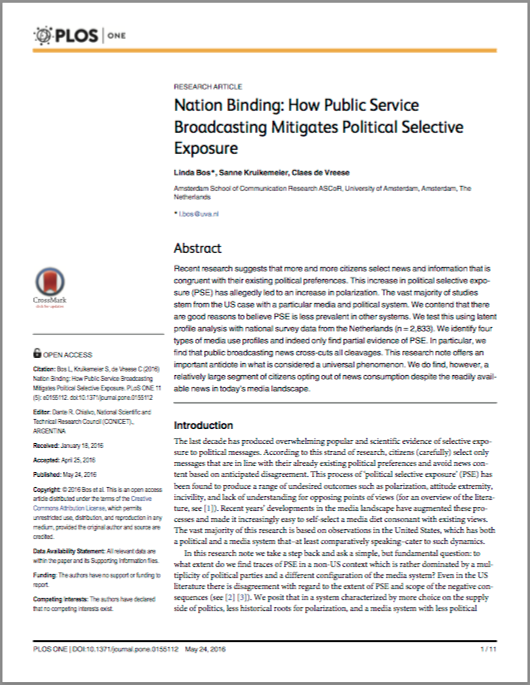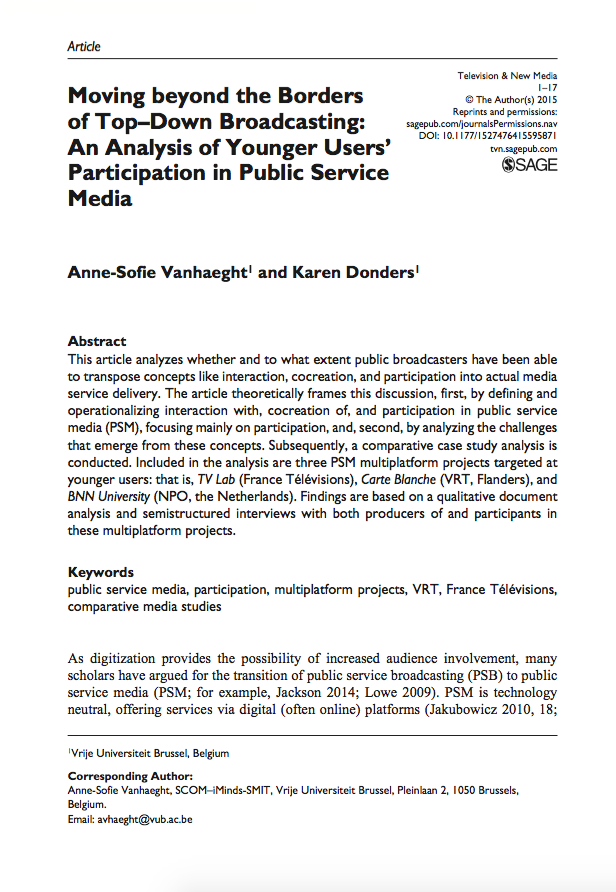Nation Binding: How Public Service Broadcasting Mitigates Political Selective Exposure
REPORT
Linda Bos, Sanne Kruikemeier, Claes de Vreese
Amsterdam School of Communication Research ASCoR, University of Amsterdam, Amsterdam, The Netherlands
(2016)
Overview
Is there a media system that promotes less political selective exposure? This article explores this question within the context of the US and Dutch media landscape, offering a comparison of the two. In particular, this article makes the case that where there is a relatively strong public service broadcaster, political selective exposure amongst an audience is lower due to its less partisan output. However, the authors do find that there is a large segment of citizens that choose to opt out of news consumption, despite its availability in today’s media landscape.
This article is Open Access, distributed under the terms of the Creative Commons Attribution License.
Moving beyond the Borders of Top–Down Broadcasting
JOURNAL
An Analysis of Younger Users’ Participation in Public Service Media
Anne-Sofie Vanhaeght and Karen Donders
Television & New Media
Vrije Universiteit Brussels, Belgium
Sage Publications
2015
Overview
This article analyses whether and to what extent public broadcasters have been able to transpose concepts like interaction, cocreation, and participation into actual media service delivery.
The article theoretically frames this discussion, first, by defining and operationalising interaction with, cocreation of, and participation in public service media (PSM), focusing mainly on participation, and, second, by analysing the challenges that emerge from these concepts.
To read the full journal article, click here.
New Zealand: Children’s Media Use Study
REPORT
“How our children engage with media today”
This research produced by New Zealand’s Broadcasting Standards Authority elucidates to the changing use of media platforms by the country’s 6-14 year olds.
The paper finds that television is still the dominant format for children although the use of tablets and smartphones is rapidly rising. It states that this age range is the biggest differentiator in media behaviour, with usage evolving as the child grows older. However, there is a clear tipping point at the age of 11 when the use of Youtube and social media rise dramatically.
The report also highlights differences between social setting, background and ethnicity in the use of different media platforms, the level of exposure and content preferences.
CRTC: Broadcasting Regulatory Policy 2015
POLICY BRIEF
“The way forward – creating compelling and diverse Canadian programming”
Published in 2015, this regulatory policy paper by the Canadian Radio-Television and Telecommunications Commission (CRTC) sets out the Commission’s findings on ways to build a future Canadian television system that encourages the creation of compelling and diverse programming made by Canadians.
The report looks to build on the current strengths of the Canadian television industry and take it into the future; ensuring its ability to develop alongside changing audience viewing habits and the growing use of on-demand services.
The Australian Communications and Media Authority
POLICY BRIEF
The ACMA is Australia’s broadcasting, internet, radio communications and telecommunications regulator. Their intention is to make “media and communications work for all Australians“.
The role of the ACMA is diverse, from online safety courses for children and parents to conducting research on the Australian media communications environment to inform decision makers. Away from education and research, the ACMA also manage Australia’s radio frequency spectrum, ensuring that it is equipped for the continuing pressures rapidly growing ownership of mobile internet devices.
As regulators, the AMCA is responsible for investigating codes of conduct and practice both on an individual and organisational level. This includes combatting the misuse of content, abuse and producing guidelines that help to protect consumer and citizen rights.
The links below take you to two of the ACMA’s most recent reports. ‘The Communications Report 2014-2015‘ reports on the “performance of carriers and carriage service providers, including consumer satisfaction, consumer benefits and quality of service“, whilst the inaugural ‘ACMA snapshot‘ (September quarter, 2015) offers an overview of the ACMA’s “broad and diverse” regulatory activities.



